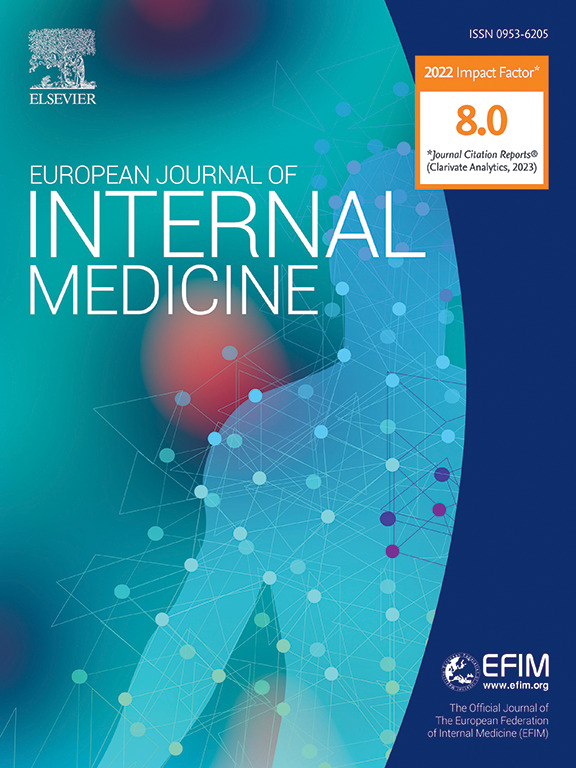Distinct biophysiological effects of Ramadan fasting and traditional intermittent fasting on markers of body fat storage. A real-life study
IF 6.1
2区 医学
Q1 MEDICINE, GENERAL & INTERNAL
引用次数: 0
Abstract
Background
Ramadan Intermittent fasting (RIF) exerts beneficial metabolic effects and improves gastrointestinal motility. However, a comparison between RIF and the traditional 16-hours intermittent fasting (16IF), a strategy for weight loss, is lacking.
Methods
A total of 34 subjects (median age 32.5 years, range 18–63 years; median BMI 24.5 Kg m-1², range 18.6–37.6 Kg m-1²) were assigned to RIF (N = 18) or 16IF (N = 16) for 30 days. We measured variations in anthropometric measures (BMI, waist, and abdominal circumference), serum insulin, glucose, cortisol, non-esterified fatty acid (NEFA), body fat composition (bioelectrical impedance analysis), and the ultrasonographic measurements of liver steatosis (Hepatorenal index, HRI) and thickness of subcutaneous (SAT) and visceral (VAT) fats.
Results
At baseline, BMI, rates of liver steatosis and distribution of normal weight, overweight, and obese subjects were comparable between the two groups. Body weight significantly decreased at the end of fasting in both RIF (-4.2 % vs baseline, P = 0.002) and 16IF (-2.1 % vs baseline, P = 0.002). Waist and abdominal circumferences significantly decreased only in RIF as well as the amount of body fat. In subjects with liver steatosis, SAT and VAT significantly decreased following RIF, but not 16h-IF, as well as the ultrasonographic HRI.
Conclusion
Both 16IF and RIF are able, during 1-month, to reduce body weight. However, RIF but not 16IF also generates marked beneficial effects in terms of reduced subcutaneous fat and liver steatosis. Further studies urge to verify the effects of different models of IF in weight-cycling and long-term management of obesity and related dysmetabolic conditions, such as ectopic fat over-storage.
斋月禁食和传统间歇性禁食对体内脂肪储存指标的不同生物生理效应。一项真实生活研究。
背景:斋月间歇性禁食(RIF)可产生有益的代谢效应并改善胃肠道蠕动。然而,RIF 与传统的 16 小时间歇性禁食(16IF)(一种减肥策略)之间缺乏比较:共有 34 名受试者(年龄中位数为 32.5 岁,范围为 18-63 岁;体重指数中位数为 24.5 千克/平方米,范围为 18.6-37.6 千克/平方米)被分配到 RIF (18 人)或 16IF (16 人),为期 30 天。我们测量了人体测量指标(体重指数、腰围和腹围)、血清胰岛素、葡萄糖、皮质醇、非酯化脂肪酸(NEFA)、体脂组成(生物电阻抗分析)以及肝脏脂肪变性(肝肾指数,HRI)和皮下脂肪(SAT)和内脏脂肪(VAT)厚度的超声波测量结果:基线时,两组受试者的体重指数、肝脏脂肪变性率以及正常体重、超重和肥胖受试者的分布情况相当。在禁食结束时,RIF(与基线相比-4.2%,P = 0.002)和 16IF (与基线相比-2.1%,P = 0.002)组的体重均明显下降。只有 RIF 的腰围和腹围以及体内脂肪量明显下降。在肝脏脂肪变性的受试者中,RIF后SAT和VAT明显下降,而16H-IF则没有,超声HRI也是如此:结论:16IF 和 RIF 都能在 1 个月内减轻体重。结论:16IF 和 RIF 都能在 1 个月内减轻体重,但 RIF 而非 16IF 还能在减少皮下脂肪和肝脏脂肪变性方面产生明显的有益效果。进一步的研究有助于验证不同模式的 IF 在体重循环和长期控制肥胖及相关代谢异常(如异位脂肪过度囤积)方面的效果。
本文章由计算机程序翻译,如有差异,请以英文原文为准。
求助全文
约1分钟内获得全文
求助全文
来源期刊
CiteScore
9.60
自引率
6.20%
发文量
364
审稿时长
20 days
期刊介绍:
The European Journal of Internal Medicine serves as the official journal of the European Federation of Internal Medicine and is the primary scientific reference for European academic and non-academic internists. It is dedicated to advancing science and practice in internal medicine across Europe. The journal publishes original articles, editorials, reviews, internal medicine flashcards, and other relevant information in the field. Both translational medicine and clinical studies are emphasized. EJIM aspires to be a leading platform for excellent clinical studies, with a focus on enhancing the quality of healthcare in European hospitals.

 求助内容:
求助内容: 应助结果提醒方式:
应助结果提醒方式:


